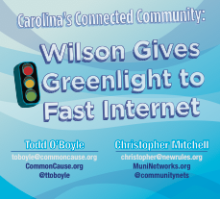
Fast, affordable Internet access for all.

New Hamsphire FastRoads is making significant strides in connecting residents, businesses, and community anchor institutions in the southwestern section of the state. FastRoads is funded by a combination of American Recovery and Reinvestment Act (ARRA) grants, private donations, and funds from local communities.
While the network is certainly making progress and scheduled for completion this summer, it has been constrained by state laws that limit the use of bonding. As a result, many local communities that would like to benefit from connections with Fast Roads will not able to take advantage of its presence in this largely rural area of the state.
We recently spoke with Carole Monroe, Executive Director of New Hampshire Fast Roads, in a Broadband Bits podcast interview. She told us about a bill in the New Hampshire General Court this year that would remove restrictions that limit how local governments can finance network investments.
In past years, New Hampshire legislators took up several bills that would remove the restriction preventing local communities from using bonds to finance broadband infrastructure. Every year, lobbyists from large ISPs manage to push those bills into oblivion. This year, HB 286 seeks to strike the restrictive language.
The bill is getting attention from local media, the New Hampshire SentinelSource. An editorial, published soon after the bill was introduced summarizes the problem:
In areas where companies determine that investing in expansion isn’t worthwhile, municipalities often find their hands tied because state law does not allow communities to take out municipal bonds for broadband access if there’s a private company operating in the community. That means if a town has even a small pocket of coverage by a telecommunication company, it can’t get funding to pay for expansion to the rest of its residents and businesses.
We enjoy bringing you news from western rural Massachusetts and the WiredWest Cooperative. We want to share the update on 2012 activities and some of the plans for 2013.
Sixteen new towns became members in 2012, which brings the grand total to 42. Business planning progressed during 2012. From the WiredWest newletter:
Significant work was undertaken in 2012 to enable financing and buildout of the network. That work was made possible by grants from the Massachusetts Broadband Institute, Berkshire Regional Planning Commission and the Central Berkshire Fund, in addition to support from donations, Cooperative membership fees, and thousands of volunteer hours.
The group also conducted a market survey in member towns. WiredWest confimed that demand is strong in the region. The organization is using the information to determine what services to offer and to support pro-forma financial statements, developed with help from groups that know the ins and outs of community broadband:
WiredWest has created comprehensive pro-forma financial statements with input from other municipal fiber networks and appropriate financial expertise. The leadership team has met with a number of public and private financing sources and advisers to refine our financing strategy and put the project on track for financing in 2013.
Franklin, Kentucky expects to see more positive economic growth when it launches its new fiber optic network. According to an article in the Bowling Green Daily News, the south central community is ready for the upgrade:
“We are super excited about it,” said James McCaslin, associate vice president of academic affairs and director of Franklin-Simpson Center. “It will be like going from 1970 to 2013 with the flip of a switch.”
We contacted Tammie Carey, Fiber Services Manager for Franklin Municipal FiberNET, and she was good enough to answer some questions. She told us that 32 miles of aerial fiber are strung in three loops around the city to ensure redundancy. She expects the network to launch near the end of January for local businesses, though the utility has already been serving one business as detailed below.
The decision was based solely on a desire to boost economic development, a sentiment echoed in the Daily News article:
It’s hard to recruit industry now if you don’t have (fiber optics),” said Dennis Griffin, industrial recruiter for Simpson County. “A lot of industries, particularly in this area, are satellite plants connected to their corporate offices, somewhere else in the United States. They all need to be connected by fiber.
“So if you don’t have that, it’s hard to compete with communities that do,” Griffin said. “Ten years ago, you could get by with T-1 lines – now most industries are just expecting that you have fiber."
Apparently, City officials contacted AT&T and Comcast several years ago and asked them to install fiber to the Franklin industrial parks. When they refused, City Leaders began pondering the possibility of a municipal fiber network. Tammie tells us about the decision in an email:
Even as the Internet is changing every aspect of our lives and communities, most Americans are intimidated by confusing jargon and misconceptions about Internet policy. We are developing a series of fact sheets that make these issues understandable to everyone.
We presently have fact sheets from the Institute for Local Self-Reliance and other organizations that cover broadband, financing networks, wireless Internet, economic development benefits from community owned networks, and the public savings from community owned networks.
Stay up to date with these fact sheets and other developments in community owned networks, subscribe to our one-email-per-week list. Once a week, we send out an update with new stories and resources.
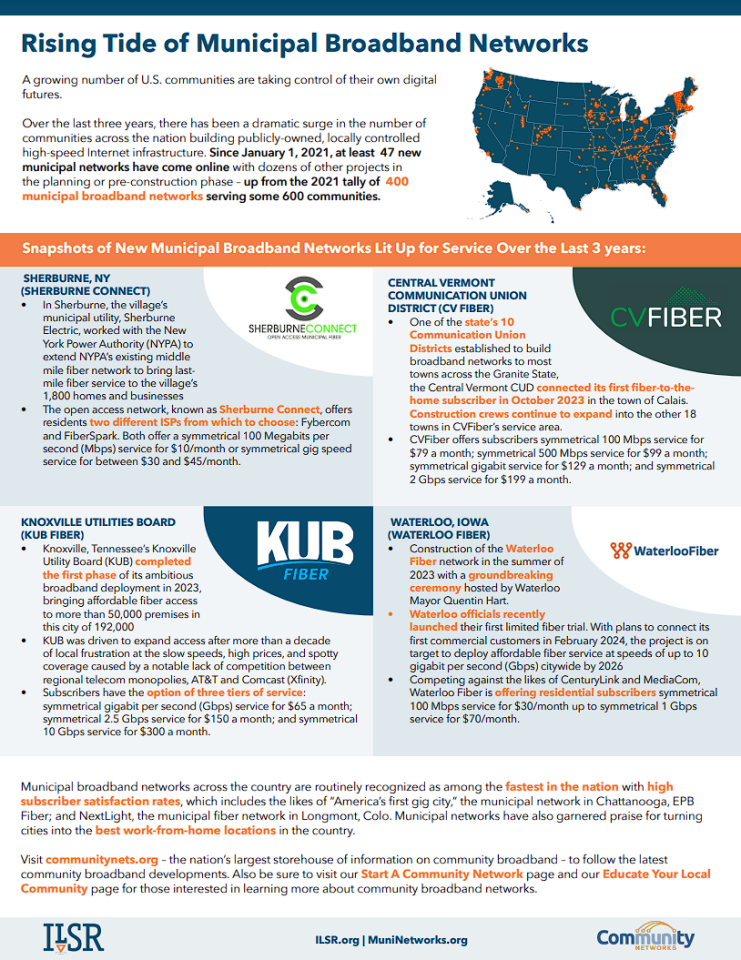
The municipal broadband movement continues to gain momentum. Since January 1, 2021, at least 47 new municipal networks have come online with dozens of other projects still in the planning or pre-construction phase, which includes the possibility of building 40 new municipal networks in California alone. To help encapsulate this dramatic surge in the number of communities building publicly-owned, locally controlled high-speed Internet infrastructure, we created this fact sheet to provide pertinent numbers and highlight four recently launched networks now providing service to communities hungry for high-quality Internet connectivity, choice, competition.
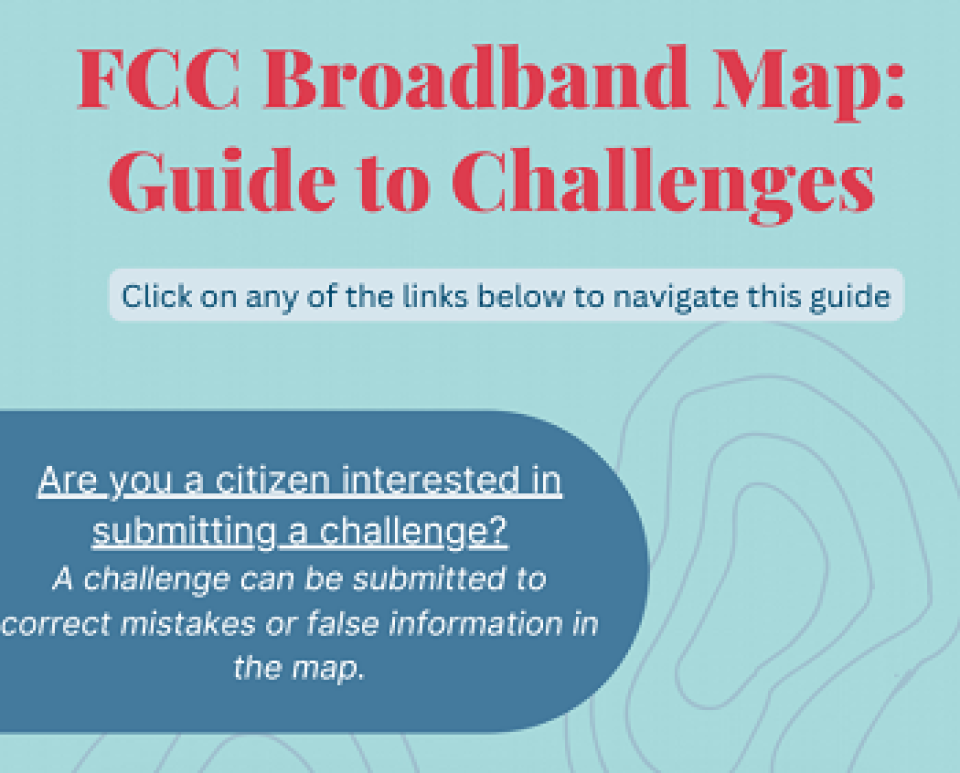
With good reason, many are confused about the information shown in the FCC's new Broadband Availability map, the challenge process, and why we should care about helping the FCC make corrections. We believe it is important to contribute to improving this map to enable an equitable allocation of Broadband Equity, Access, and Deployment (BEAD) Program funds to states next year. In an effort to provide a better understanding of the map itself and the challenge process we created a short series of instructional videos and a click-through guide. FCC Broadband Map Challenge Guide [pdf]
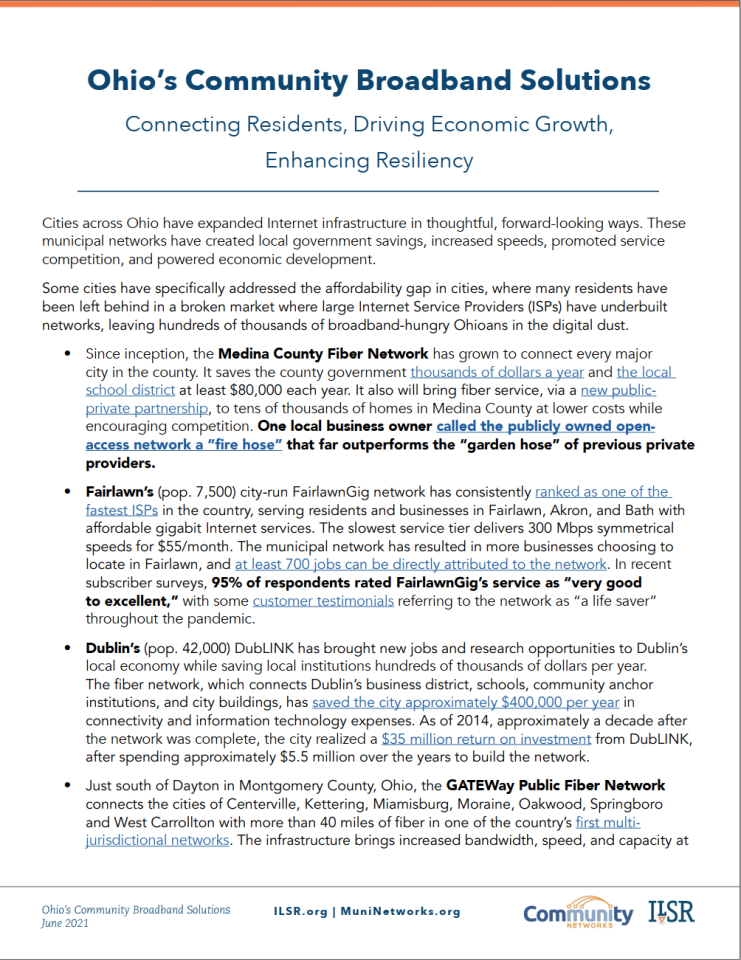
Cities across Ohio have expanded Internet infrastructure in thoughtful, forward-looking ways. These municipal networks have created local government savings, increased speeds, promoted service competition, and powered economic development. Some cities have specifically addressed the affordability gap in cities, where many residents have been left behind in a broken market where large Internet Service Providers (ISPs) have underbuilt networks, leaving hundreds of thousands of broadband-hungry Ohioans in the digital dust. This fact sheet outlines the many long-term benefits that municipal broadband projects have brought to the state.
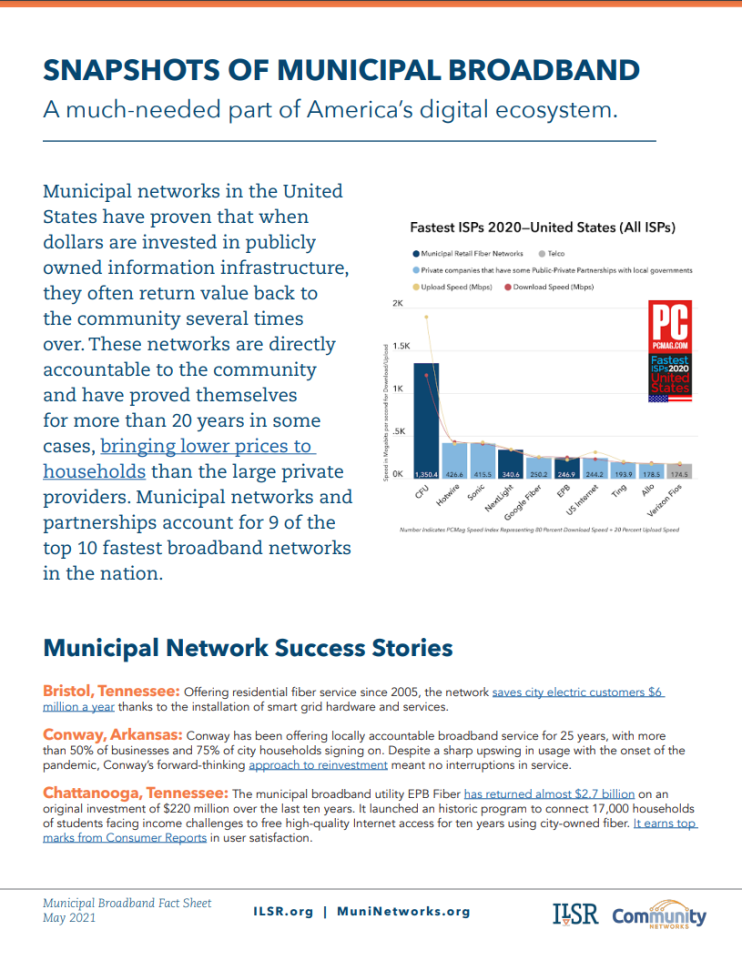
Municipal networks in the United States have proven that when dollars are invested in publicly owned information infrastructure, they often return value back to the community several times over. These networks are directly accountable to the community and have proved themselves for more than 20 years in some cases, bringing lower prices to households than the large private providers. Municipal networks and partnerships account for 9 of the top 10 fastest broadband networks in the nation. This new fact sheet highlights municipal broadband success stories from across the country and some of the many benefits the networks have brought to the communities they serve.
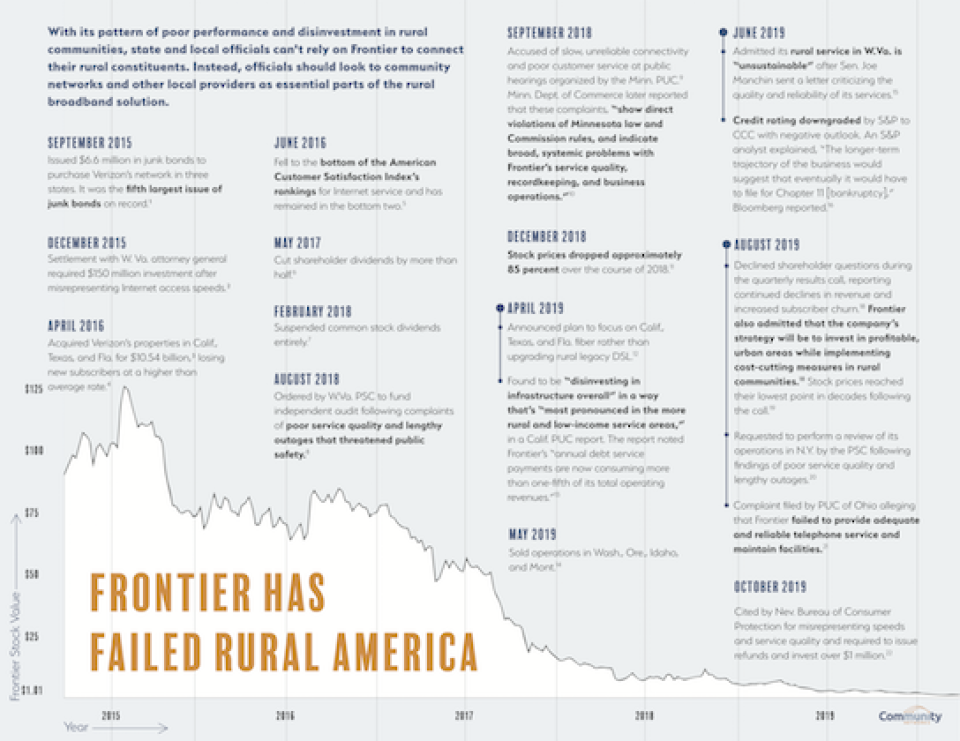
Despite raking in hundreds of millions in government broadband subsidies, Frontier Communications has failed time and time again to bring reliable, high-speed connectivity to the rural communities it serves. Instead of investing in network upgrades, Frontier has neglected its rural infrastructure to the detriment of its subscribers and the company’s own financials, with its worsening service quality paralleling its plummeting stock value. This fact sheet presents evidence of Frontier’s negligence and suggests that rather than continuing to trust Frontier, government officials should look to publicly owned and community-minded providers to connect rural residents, businesses, and institutions.
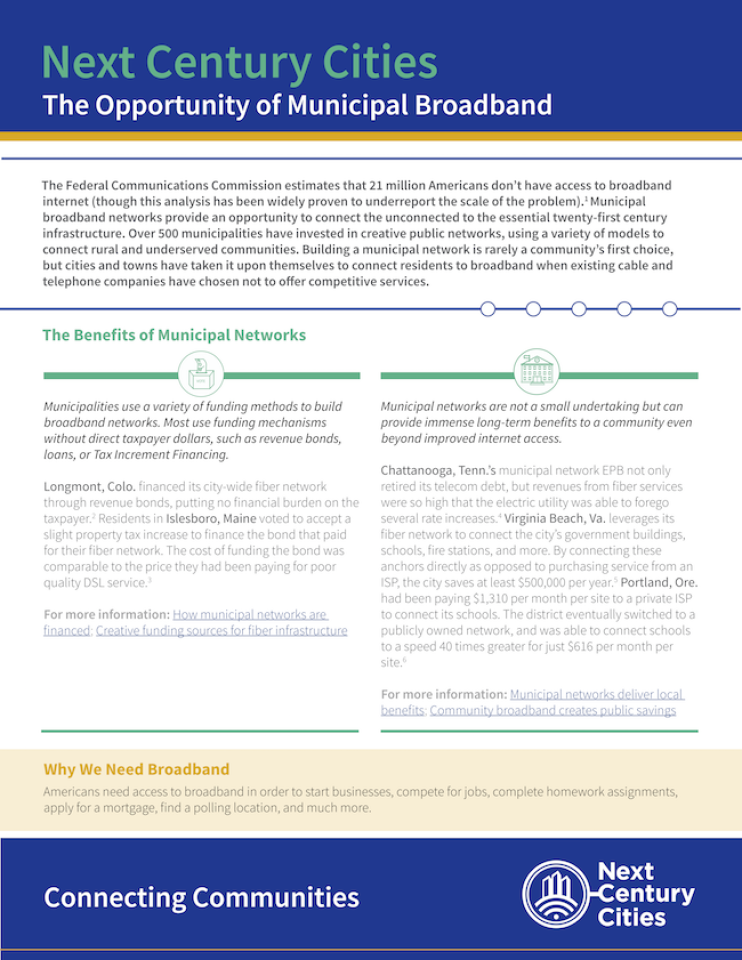
Next Century Cities (NCC) helps communities across the U.S. connect to each other, find resources, and discover ways to improve local Internet access options. NCC’s fact sheet uses examples from municipal network history. Communities have invested in publicly owned fiber optic infrastructure to obtain better connectivity and to reduce telecommunications costs for municipal facilities. In more than a few places, those investments became the foundation for what later became networks to serve local businesses and residences. The fact sheet also delves into other benefits, such as economic development, improved efficiency of other utilities, and accountability.
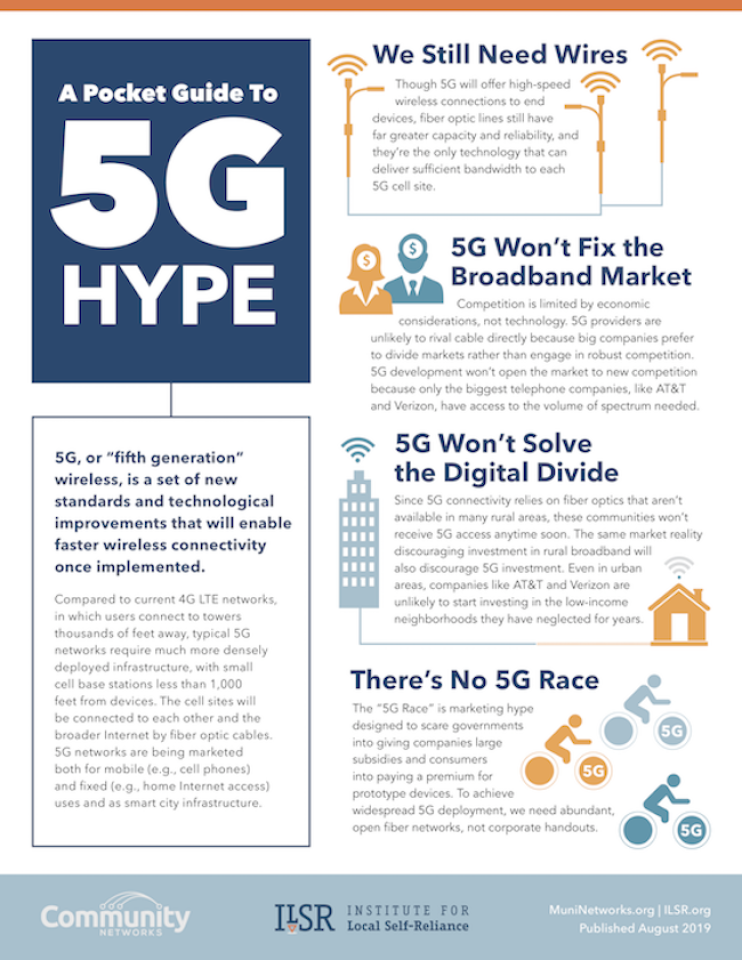
It’s difficult to separate 5G fantasy from reality as reported in traditional news sources. Misunderstandings surrounding the demands and capabilities of 5G has snowballed, creating an incorrect assumption that the technology will solve America’s many connectivity problems. It’s true that 5G is an improvement, but it has limitations. This fact sheet addresses the most repeated errors surrounding 5G and explains why the technology should be considered another tool, not an exclusive remedy.
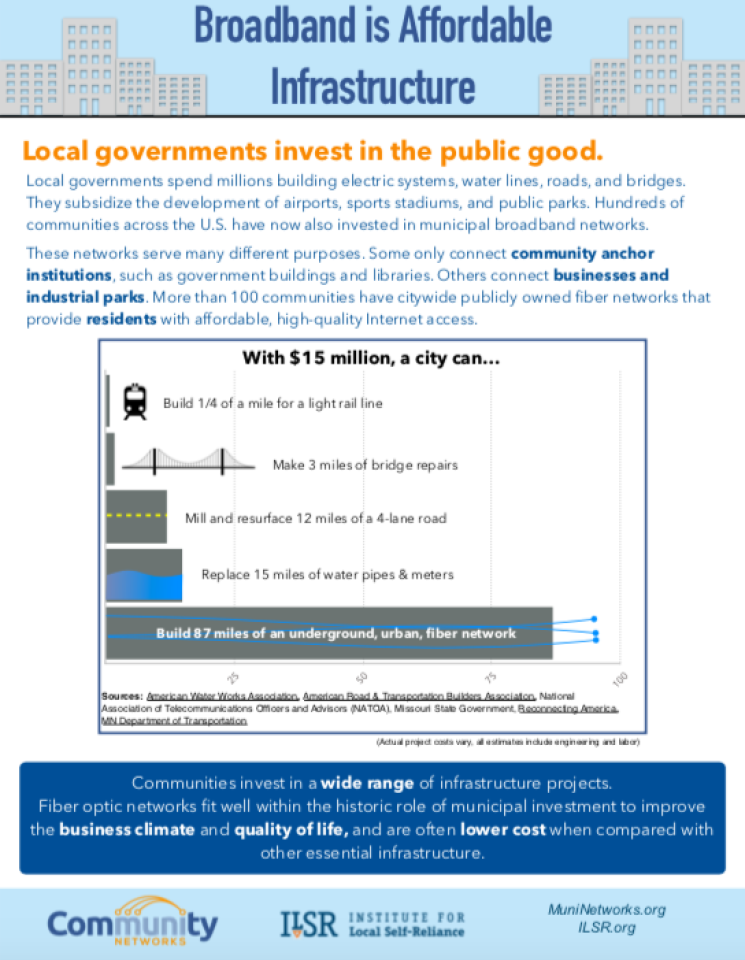
Local governments spend billions on all sorts of infrastructure every year to advance the public good for their communities. Roads and bridges keep day-to-day activity moving. Investments such as water and sewer infrastructure keep cities clean and livable. Fiber infrastructure is used for a wide range of purposes, including economic development, education, and to keep a city’s administration connected. To get a look at how fiber network infrastructure compares to other public investments, we've developed the Broadband is Affordable Infrastructure fact sheet.
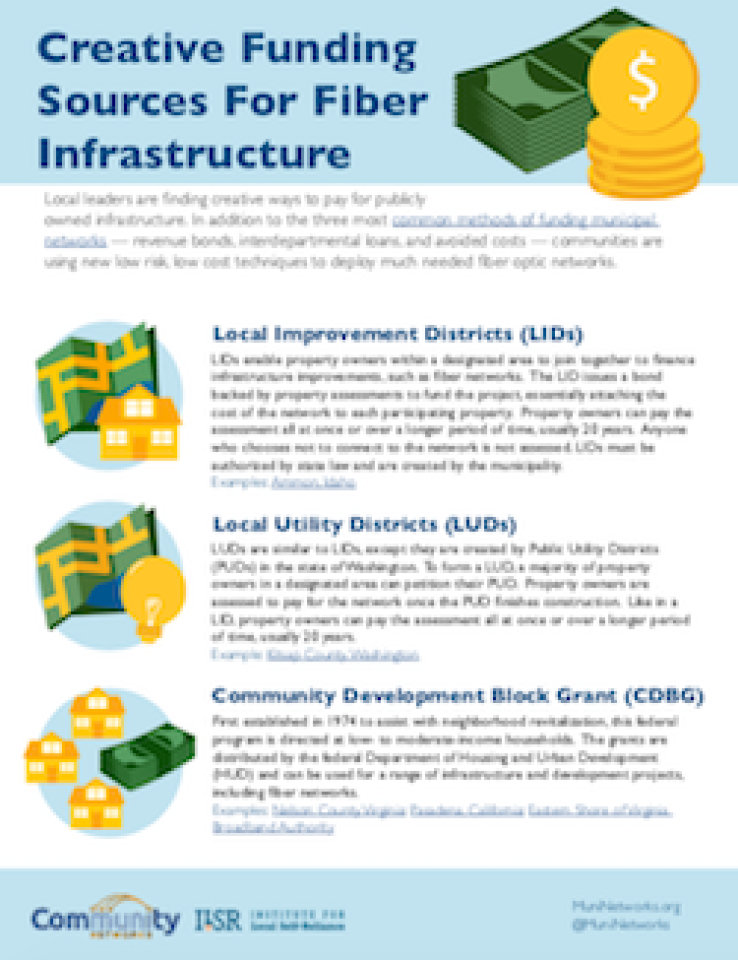
As interest in publicly owned broadband network infrastructure increases, local communities seek new ways to fund municipal networks. Revenue bonds, interdepartmental loans, and avoided costs have been the three most common methods for funding Internet network infrastructure, but local leaders are finding creative approaches to get the job done. In this fact sheet we analyze some new approaches to funding fiber optic infrastructure, pros and cons, and offer some examples.
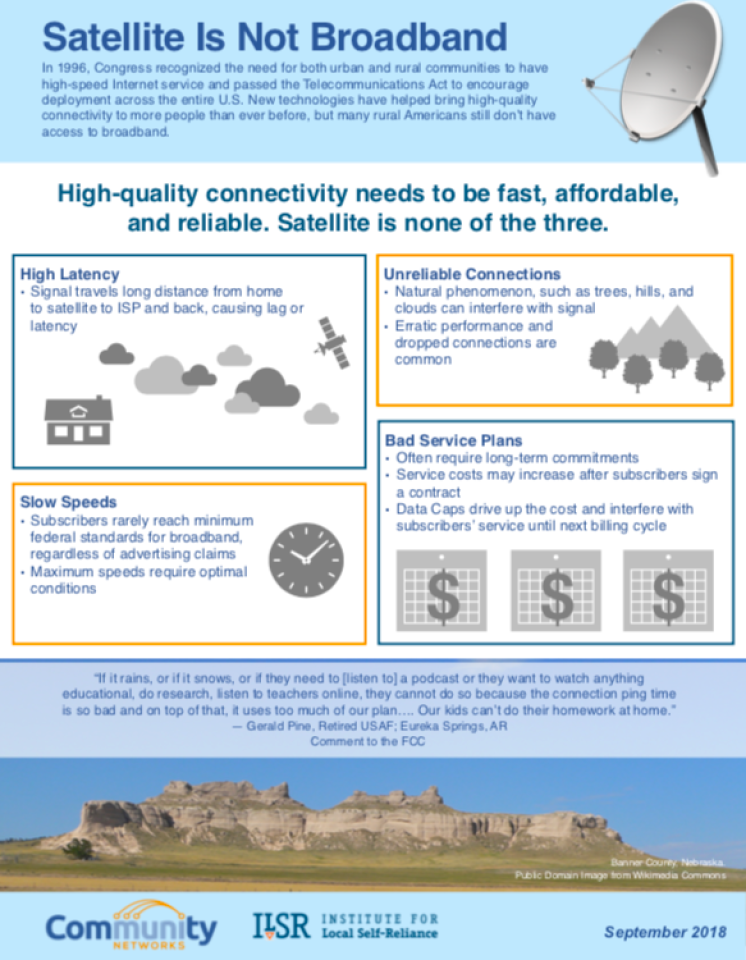
As a nation our goal is ubiquitous broadband coverage so every person, regardless of where they live, can obtain the fast, affordable, reliable Internet access necessary for modern times. For people in rural areas, where large national wireline providers don’t typically invest in the infrastructure for high-quality connectivity, satellite Internet access is often their only choice. In this fact sheet we address some of the reasons why depending on satellite Internet access to serve rural America is a mistake.
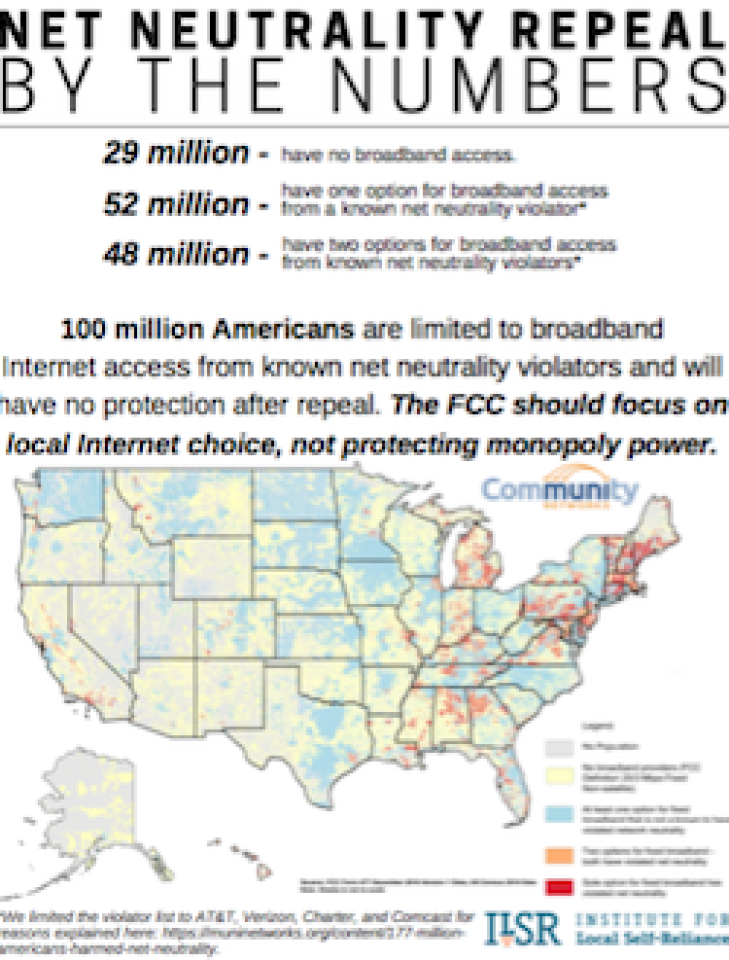
As the vote to repeal network neutrality protections approached in 2017, we started digging into the FCC’s data to determine how eliminating the policy would affect subscribers whose ISPs might take advantage of future changes. We learned that, due to existing monopoly and duopoly conditions, many millions of people would have no recourse but to pay known network neutrality violators for Internet access. We developed visuals and facts sheets with frank data that describes the problem in the U.S., California specifically, and on the East Coast from Maine to Virginia.
Net Neutrality Repeal By The Numbers, U.S.A. Edition fact sheet [pdf].
Net Neutrality Repeal By The Numbers, California Edition fact sheet [pdf].
Net Neutrality Repeal By The Numbers, East Coast Edition fact sheet [pdf].
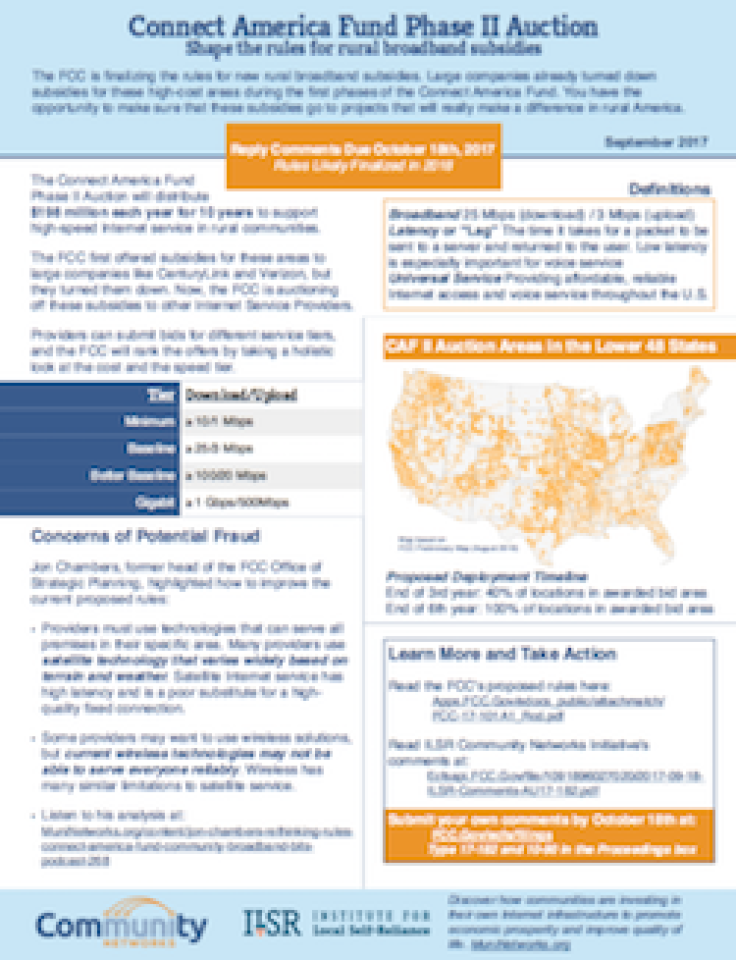
The Federal Communications Commission (FCC) manages the CAF program, which provides billions of dollars in subsidies to Internet service providers for areas where the cost of building networks is prohibitive. Some large providers decided not to accept some of the subsidies during Phase I - about $198 million annually for 10 years. This fact sheet details the most important aspects of the Connect America Fund (CAF) Auction. What is it? What should it do? Who does it affect?
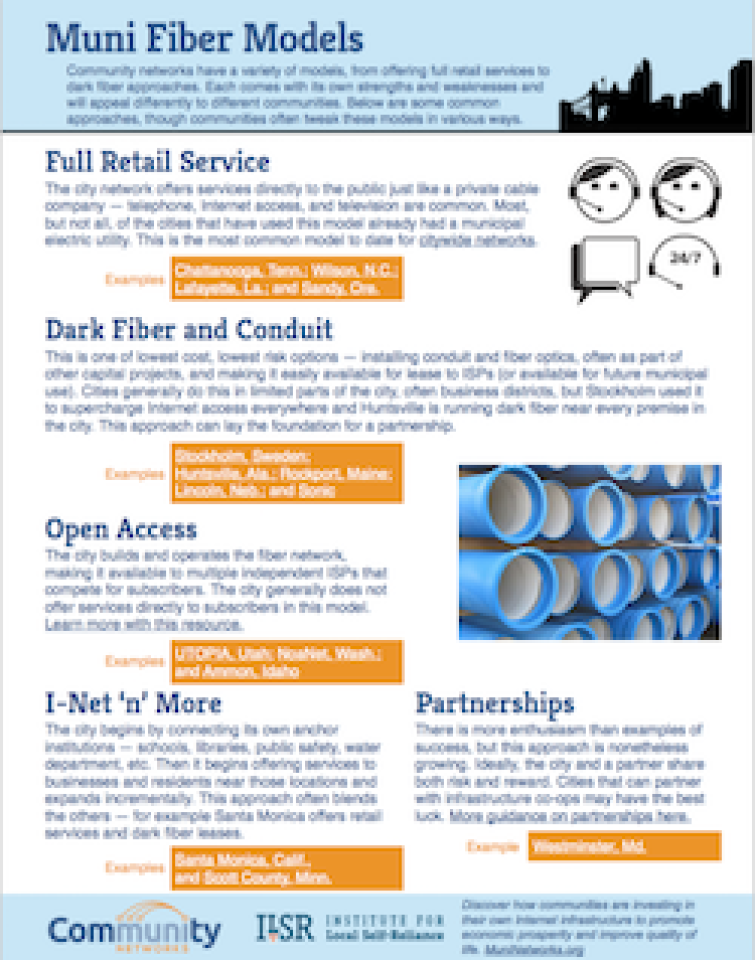
When you think “municipal fiber network,” you may think Chattanooga or Wilson, North Carolina - places where the city utility offers retail services directly to subscribers. That’s only one of several possible models that are emerging as an increasing number of communities use publicly owned assets to improve local connectivity. This fact sheet offers five of the most well known models that local governments are investigating and implementing as they become more self-reliant. Examples and characteristics of each model help illustrate.
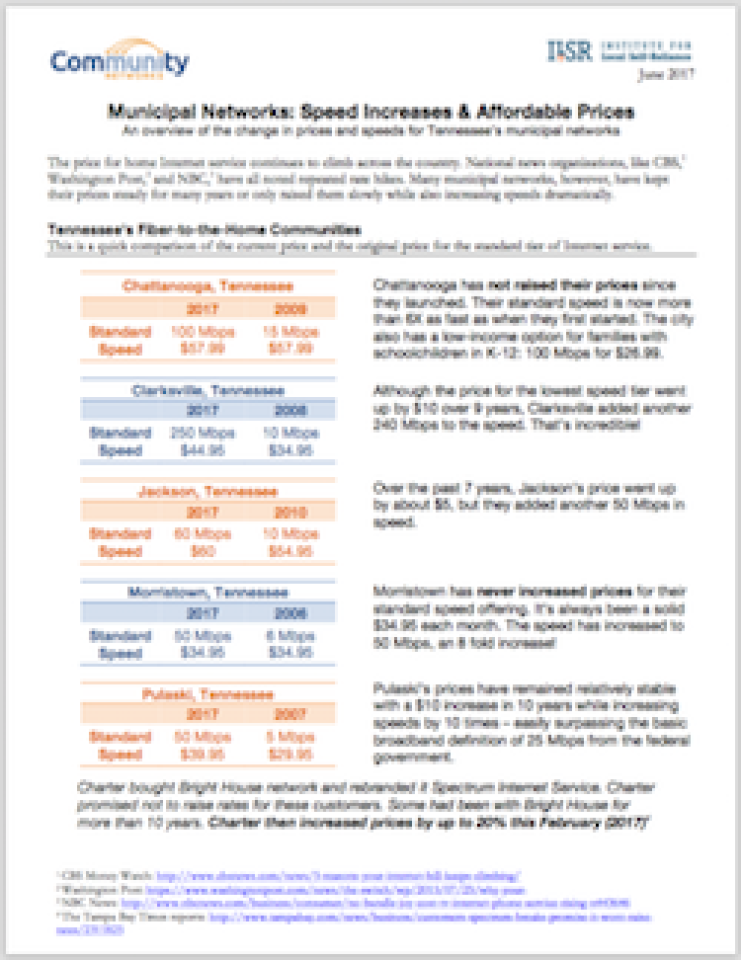
The large corporate national Internet Service Providers seem to raise their monthly rates every year but don’t give subscribers anything more for their money. On the flip side, we noticed that municipal networks tend to increase speeds for subscribers with very modest or no price increases over long periods of time. In order to illustrate this phenomenon, we looked back in time at rates and speeds in eight Tennessee communities that have invested in publicly owned Internet network infrastructure. You will see how speeds have increased significantly, but rates have only inched up.
Municipal Networks: Speed Increases & Affordable Prices [pdf]
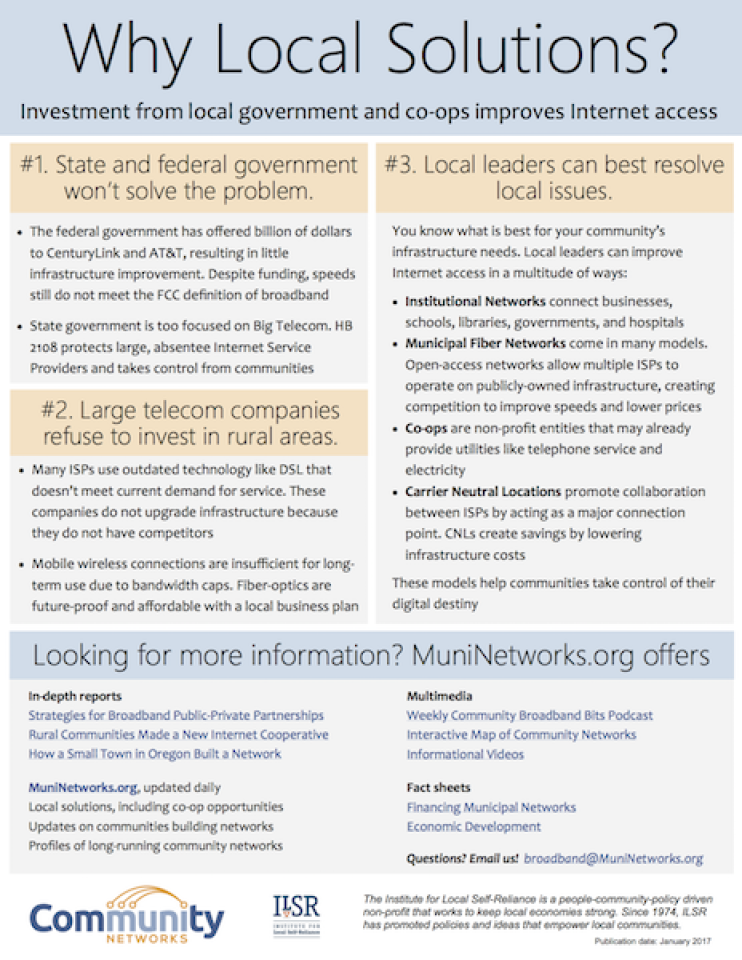
The next time you’re attending a city council meeting, a local broadband initiative, or just chatting with neighbors about better local connectivity, take a few copies of our fact sheet. In addition to providing some basic talking points to get the conversation moving, the fact sheet offers resources to guide you to more detailed information on publicly owned Internet networks. You've already started to get people interested in all the advantages of high-quality connectivity, now show them how local self-reliance it the most direct route to better access.
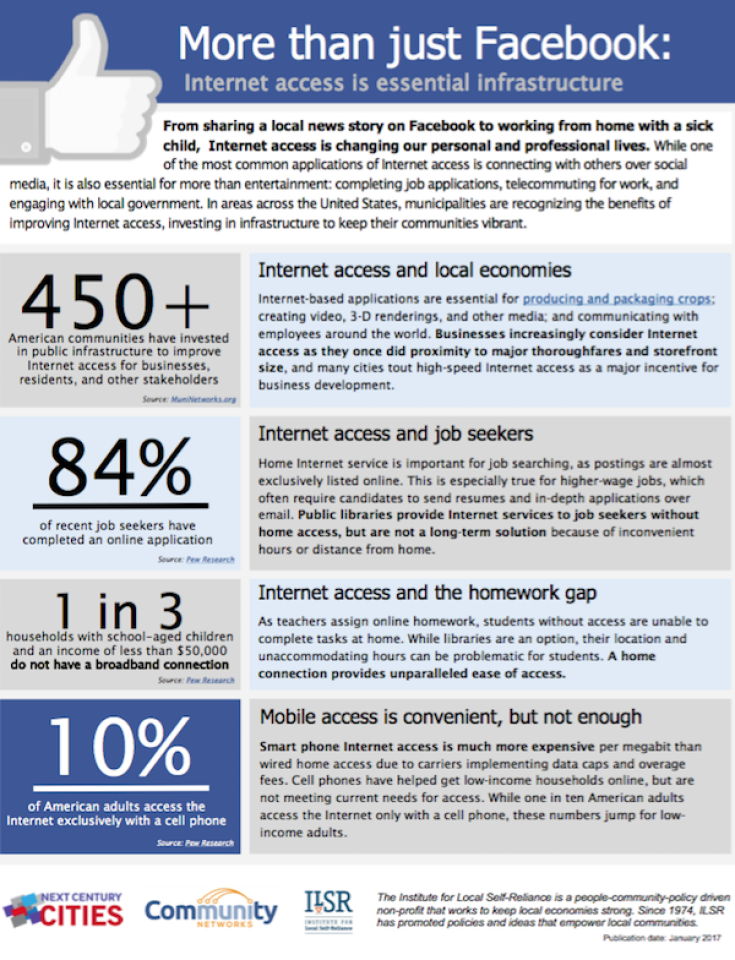
This fact sheet provides an overview on how Internet access and fast, affordable, reliable connectivity reaches most aspects of our lives. It provides statistics on economic development, education, and methods of delivering Internet access and is a good introductory tool that points out how Internet access is much more than just social media.
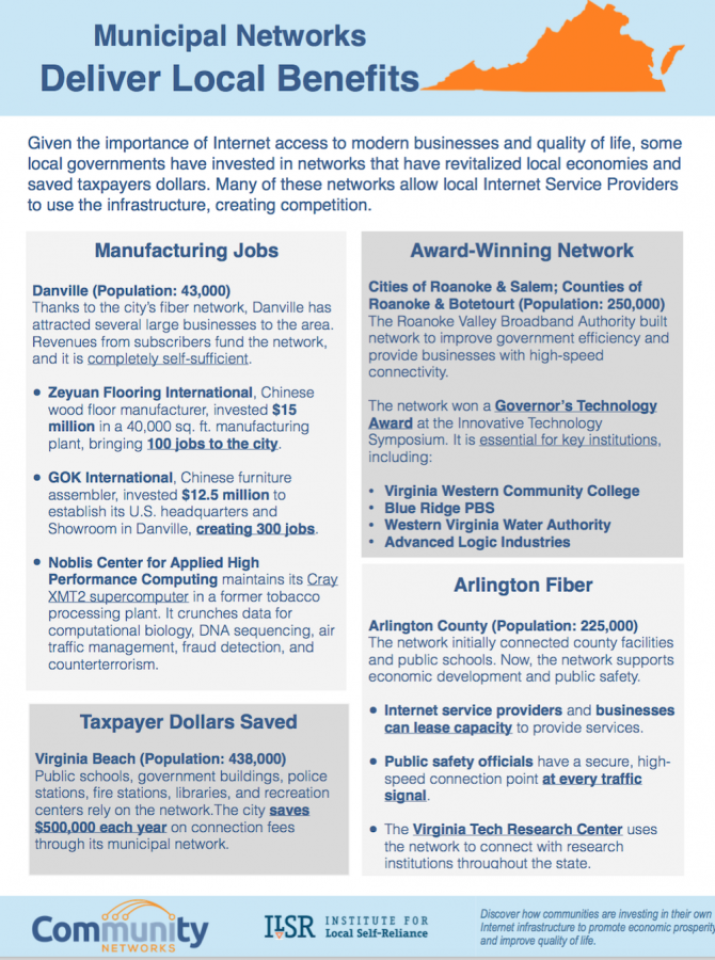
This fact sheet on municipal networks in Virginia describes how economic development, public savings, and better connectivity have contributed to the health of local communities with publicly owned networks. Virginia local governments have improved public safety, healthcare, and connectivity in local schools. Rural areas are better able to compete for high-tech and manufacturing jobs because high-speed connectivity is now an essential service for day-to-day business.
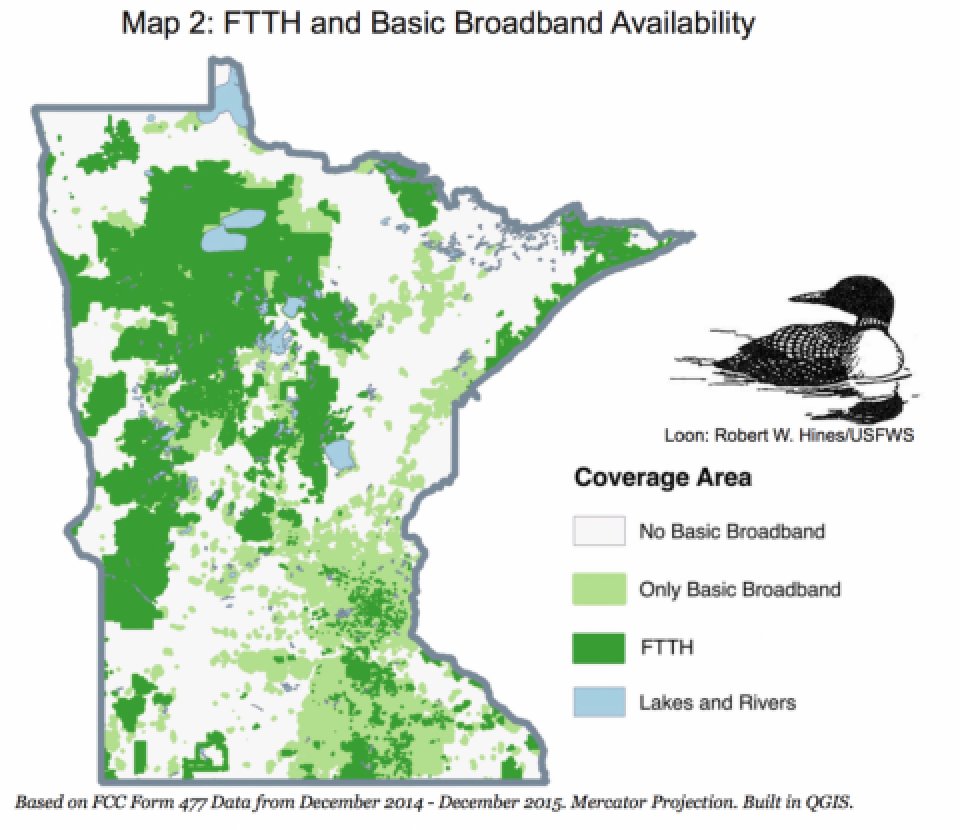
This fact sheet highlights the great work that Minnesota cooperatives and municipalities have done to bring fast, affordable, reliable Internet service to rural areas throughout the state. They've built many Fiber-to-the-Home (FTTH) networks, but there is still much work left to do. One in 4 Minnesotans lives in a rural area, and of those rural households, 43 percent lack access to broadband, defined by the FCC as 25 Megabits per second (Mbps) download and 3 Mbps upload. Resilient, robust, fiber is the long-term goal, but fixed wireless can help extend coverage in hard-to-reach rural areas.
Minnesota Cooperatives and Local Governments Can Solve Rural Digital Divide[pdf]
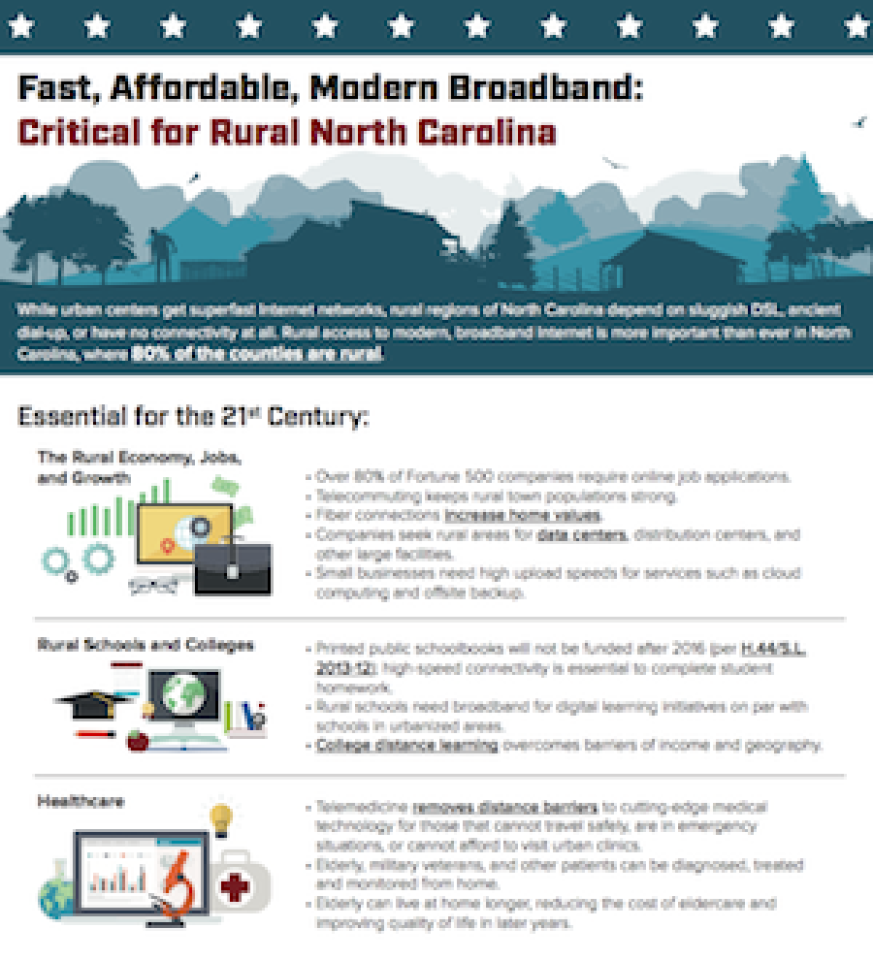
This fact sheet emphasizes the deepening divide between urban and rural connectivity. The fact sheet can help describe why people who live in the country need services better than DSL or dial-up. This tool helps to visualize the bleak situation in rural North Carolina, how it can be improved, and offers links to resources.
Fast, Affordable, Modern Broadband: Critical for Rural North Carolina [pdf]
Communities across the nation have invested in publicly owned cable and fiber infrastructure. ILSR's Community Networks Map documents over 500 communities where municipal networks serve residents and businesses. This fact sheet provides a quick introduction to the interactive online map.
When a community decides it needs to establish its own publicly owned network infrastructure, one of the biggest challenges is financing the investment. Each community is unique but three main methods of financing are most popular. This fact sheet offers a quick look at these common approaches and provides real-world examples.
This is a handy resource for elected officials and activists that are confused by some of the jargon or just want to make sure they understand some key ideas around broadband and telecommunications.
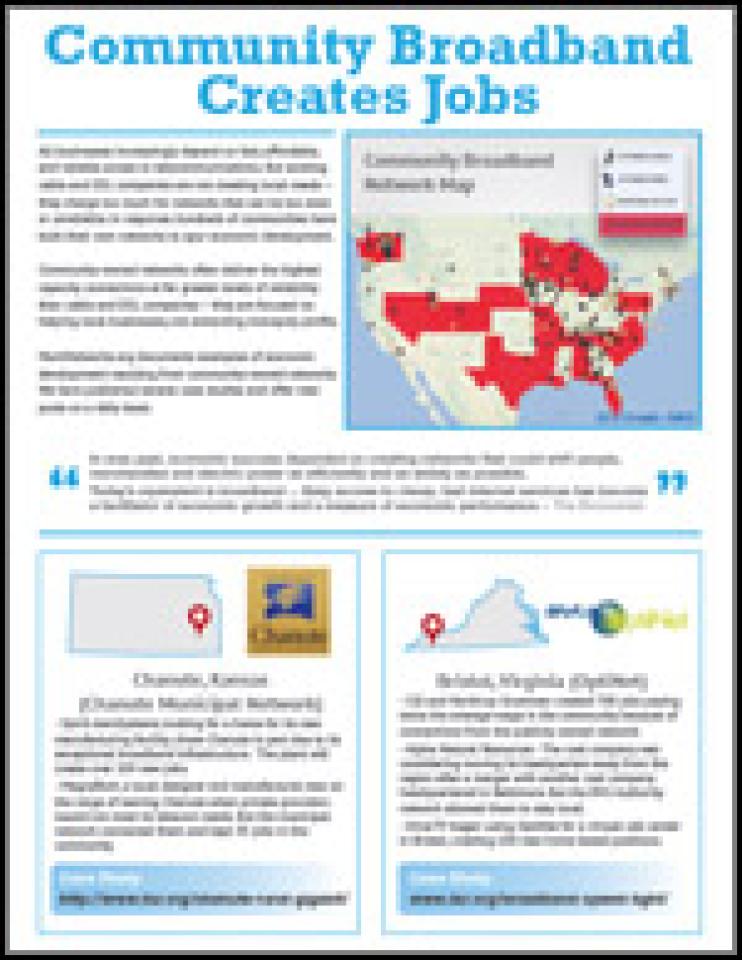
Community Broadband Networks have a very good track record in creating jobs. This fact sheet details where publicly owned network attracted new businesses or helped existing businesses to thrive.
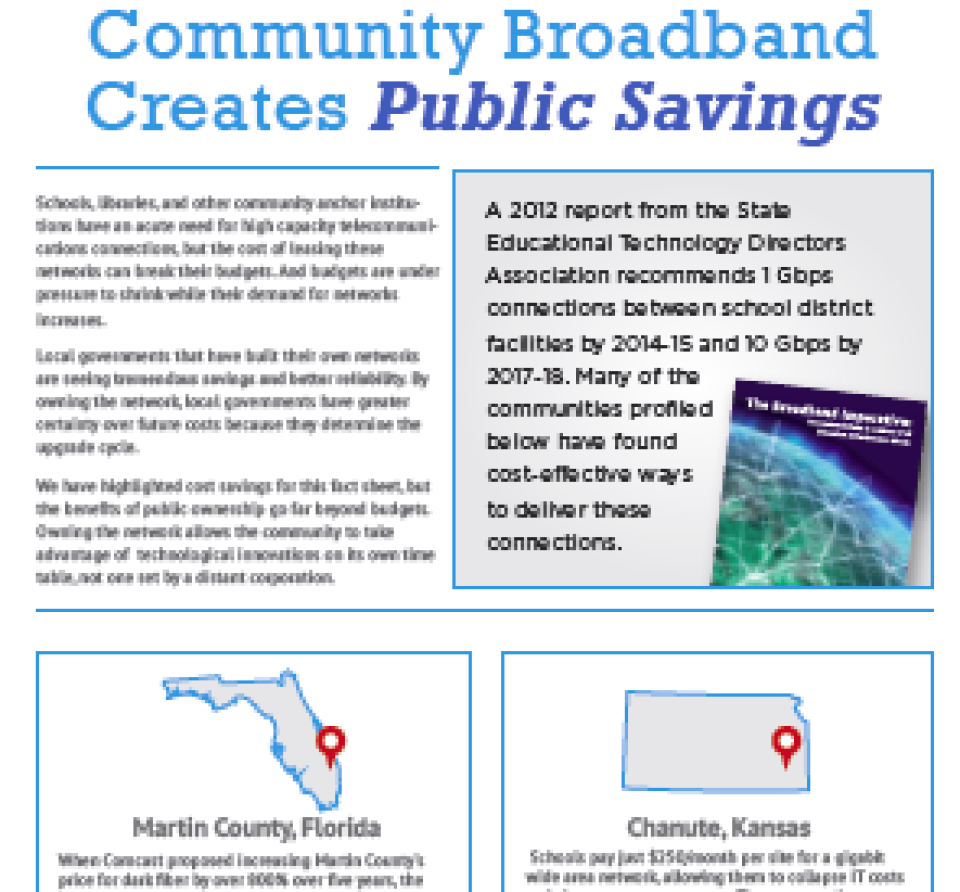
Though schools, libraries, and other community anchors need access to faster, more reliable networks, the big cable and telephone companies have priced those services so high that they are breaking the budget. But when communities create their own connections, affordable high capacity connections aren't the only benefits.
Wireless networks may appear to be magical, but are actually driving investment in fiber optic wires. This resource defines many terms, key points, common speeds, and offers insight into wireless technology and policy.
This 2 page fact sheet explores the issue of preemption - how at least 19 states have made it impossible or more difficult for communities to build their own networks. It includes some history, legal issues, and quotes from FCC Commissioners.
Cottage Grove, Oregon, is on the cusp of adding up to 250 new jobs with the aid of its fiber optic network. A recent Register-Guard.com article by Serena Markstrom details the potential project between the City and First Call Resolution. The company is interested in expanding to a Cottage Grove shopping strip. While the space is the right size and location, it does not have the needed telecommunications connections for a high-capacity call center.
The City is looking into expanding its fiber optic network to accommodate First Call. City leaders will seek a state economic development grant and recently approved funding for an engineer's construction plan to lay the cable to get an accurate cost estimate. Initial estimates are $450,000 for an entire underground installation. Council members have already suggested that the expansion makes sense, regardless of whether or not First Call becomes a tenant. The 7 miles of fiber are primarily located in the southern part of the city while the shopping strip is in the north.
The City Manager Richard Meyers hopes the added infrastructure will bring more than just First Call Resolution to the shopping strip. From the article:
The commercial strip being considered for the call center has much empty space. “The whole plaza needs help,” Meyers said. “We need to do something to see if we can get other things in there.”
If more businesses moved in and started leasing the cable, the city could collect money — just like any utility — from those who tapped into the network and use those funds to continue to expand fiber optic cable around town, Meyers said.
“With our fiber and what we’ve developed, we’re within 4,000 feet of connecting” to the Village Center, he said. “That’s how close we are,” he said. “It’s not a huge distance. We can do it. (It would be a) piece of cake to connect our system to his network and so all of [First Call Resolution's] call centers would be on the same network.”
The city network also offers a Wi-Fi network throughout 80% of the city. Rates vary, ranging from 10 free hours each month at 128 Kbps to 7 Mbps unlimited with tech support for $50 per month. According to the CGWiFi website:
Fiber optic connectivity is coming soon for public facilities in Kings Mountain, North Carolina. The city has its own electric, natural gas, and water utilities and is home to a little over 10,000 people. Located along the southern edge of the state, the town is considered a suburb of Charlotte.
According to an Alicia Banks Gaston Gazette article, the City Council unanimously approved contracts to start construction and most of the city departments should be on the network before the end of the year. The city fiber optic cables amount to nine miles in length. Savings will be about $65,000 annually as the city uses its own fiber to supply phone and Internet connections rather than lease services. From the article:
“We should start seeing the savings within seven years,” Kings Mountain Mayor Rick Murphrey said. “It’s cheaper to use your own fiber optics."
Though seven years may seem like a long time to wait for savings, recall that these connections will be needed indefinitely. Further, these networks often lead to unanticipated benefits that can make the savings occur faster than forecast.
The entire project will cost $495,722 under a five-year payment plan. Also from the article:
“Taxpayers' dollars are helping to pay for this, but no increase,” Murphrey said about rates. “(Funds will also) come out of the electric, gas and water fund.”
Kings Mountain is another community choosing to use their current fiber resources to provide broadband to city facilities and save taxpayer dollars. Our recent Public Savings Fact Sheet, highlight a few of many other communities that choose this route.
Kudos to Richard Downey, Village Administrator for the Village of Kronenwetter in Wisconsin. Mr. Downey reminded us that we have yet to write about the fiber network in Princeton, Illinois. While we have noted Princeton in our list of economic development successes, we haven't delved into the network that serves the city, the schools, and the business community.
Princeton is home to about 7,500 people and is located in the north central region of the state in Bureau County. They have their own electric, water, and wastewater utilities and began offering broadband connectivity in late 2003. We spoke with Jason Bird, Superintendent of Princeton Electric Department, who shared the network's story with us.
In 2003, the city’s largest electric and water consumer was also the largest employer. At the time, incumbents served the community with T1 connections. The manufacturing company moved to Mexico, taking 450 jobs with it. The community was stunned.
Approximately 6 months later, Ingersoll Rand, the community's second largest employer with about 300 jobs, also considered moving away from Princeton. While lack of needed broadband was not the only reason, the Ingersoll Rand CEO let community leaders know that it was one of the influential factors. The company liked being in Princeton, and the city would have been on the top of the location list if not for the sad state of connectivity. At the time, the only commercial option was unreliable T1 connections for $1,500 - $2,000 per month. If Ingersoll Rand moved, the community would experience job losses equal to 10% of the population. Community leaders needed to act and do it quickly.
To retain Ingersoll Rand, the City Council decided unanimously to go into the telecommunications industry. They issued an RFP and encouraged incumbents AT&T and Comcast to bid; neither were interested. (Interestingly, once Princeton let it be known that they were going to build the network without them, there were some local upgrades from both companies.)
This past spring, we introduced you to the small town of Leverett, in rural western Massachusetts. Having been largely ignored by the cable companies and left behind by Verizon's DSL service, the community overwhelmingly approved a town-owned network initiative in a May vote. They decided to finance the FTTH network with a 20-year bond measure.
The debt will be serviced by both the revenues from selling services on the network and a modest increase in property taxes estimated at 6%. Local leaders calculate the increase in property taxes will amount to less than the savings created by lowering existing DSL and telephone services.
Peter d'Errico, of the Leverett Broadband Committee gave us an update via email:
We issued a Request for Information (RFI) in September. Thirteen respondents gave us a wealth of information about the state of the industry and their readiness to engage with our project. Based on this information, together with our already-completed network design, we are now crafting an Invitation for Bids (IFB) for the network build and one year's maintenance. We expect to issue the IFB early January, with a return date in February, which will allow us to select a contractor shortly thereafter.
As soon as we issue the IFB, we will draft a Request for Proposals (RFP) for network operator / service provider. This will also be based on the information gathered from the RFI and our design.
We have initiated the 'make-ready' process with the local utility and phone company.
A November Gazette.Net article [requires login] on the project described some temporary setbacks due to Hurricane Sandy and an October storm that came through the area. In order to keep the project momentum going, the committee is gathering the pieces needed now and in the future. Early prep work will make launching the network that much easier. From the article:
Back in 2010, we reported on the municipal network in Spanish Fork, Utah. Back then, the utility innaugurated its telephone service, which completed its triple play offering. With recent discussion around Utah's UTOPIA, Spanish Fork is getting a second look.
A Cimaron Neugebauer, Salt Lake Tribune article, highlights the success of the Spanish Fork Communications Network (SFCN). When we last reported on SFCN, 60% of residents subscribed to its cable television and high-speed Internet service. Two years later, the numbers are even higher:
Spanish Fork runs its own municipal network to deliver telephone, cable TV and Internet services. The network has deep ties with the community and is popular with residents, nearly 80 percent of whom are customers.
"It’s exciting to live in community that invests in this kind of thing," resident Bret Bills said.
A combination of bonding and borrowing paid for the $7.5 million network including a municipal electric utility substation. Construction began in 2001. The investment continues to pay off:
Today, the city currently makes about $1 million a year profit from the service and its bonds of $600,000 annually will be paid off in 2015.
The network is a combination of fiber and coax cable. As is often the case, the community acted to fill the gap left by the failure of the private sector, involving the community along the way. From the SFCN website:
SFCN offers services that no other company will provide and can only be implemented by the public sector. The Spanish Fork Community Network has been established to serve the residents of Spanish Fork, not the interests of some large corporation. We have involved the citizens of Spanish Fork since the systems inception through a local Citizen's Ad Hoc Committee and it has ensured the system is design to meet the needs of Spanish Fork.
Unlike UTOPIA, SFCN is able to offer retail services, having been grandfathered in at the time of the crippling Municipal Cable TV and Public Telecommunications Services Act.
